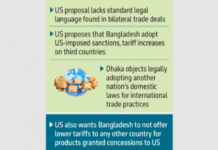
If you happen to come upon t-shirts being sold in the United States or the European Union (EU), the chances are that the Vietnamese ones have outdone the Bangladeshis, securing twofold the export price.
To give an idea of the margin, let’s take an instance in the EU in 2020 cited by the Centre for Policy Dialogue (CPD) in a research last month.
Against every 100 kilogrammes of t-shirts, Vietnam managed to fetch $2,157.90 last year, whereas it was $1,091.50 for Bangladesh.
This did not come out of the blue. In 2019, the rates were going at $2,099.70 and $1,097.50 respectively.
The same story was repeated in the US, another major export destination for both nations.
Closer inspection reveals the most visible edges: the quality of Vietnamese fabrics being substantially better and a section of its people having a taste for high-end products.
Other factors are also at play, asserting better prices in the major markets, says Khondaker Golam Moazzem, the CPD’s research director.
Some 75 per cent of a garment item’s raw material comprises the fabric, while the rest accessories, he said.
The use of a higher quality of fabric guarantees Vietnamese manufacturers better prices from buyers, he explained.
Plus, Vietnam has a higher number of upscale product brands and retailers, he added.
This results from a better country image, a higher ranking in the ease of doing business index of the World Bank, and the inclination towards compliance, human rights, and environmental protection practices, he said.
Their locals manufacture garments focusing on the upmarket, albeit on a limited scale. “We need to mass manufacture upscale garment items to get better prices and for more export,” Moazzem said.
Moreover, Bangladesh needs a facelift and capacity improvements so that customers come over in drove to source upscale products, he said.
While Bangladeshi investors can start increasing the production of high-end garment items, foreign investment could be attracted in higher volumes, he added.
Local exporters are on the same page with Moazzem.
Though Vietnam was a latecomer in the global garment business, it turned into a major player quickly for its geographical proximity with China, the global leader in the apparel business.
Vietnam’s current success can be attributed to the associated investment shift from China, said AK Azad, managing director of Ha-Meem Group, one of the leading local garment exporters.
As a result, Vietnam has a lower lead time, allowing shipping garments to the EU in 30 days, while it takes 90 days for Bangladesh, he said.
Vietnam also enjoys close geographical proximity with Europe, for which it comes second in priority preference after China to international retailers and brands, he added.
“Besides, it makes good use of its highly available, top quality raw materials.”
Bangladeshi garment suppliers suffer from the lack of a deep seaport, and having one could have reduced business operation costs and delivery time, Azad said.
“We need to improve our products because buyers want to do long-term business with local suppliers if they are satisfied with the initial work orders.”
“The buyers do not want to change their sources because of the pandemic frequently,” he said, adding that customers were prepared to pay higher prices for quicker deliveries.
KM Rezaul Hasanat, chairman and chief executive officer of Viyellatex Group, another top garment exporter, said the country image was a very important factor when fixing prices of garment items.
The same could be said for raw materials, he said.
Moreover, many high-end Chinese garment manufacturing units have relocated to Vietnam, which acted as a big factor in securing higher prices for Vietnamese apparel, he added.
Vietnam is strong in manufacturing outerwear for people living in cold climates alongside high-quality blazers and woven formal shirts and trousers in the EU and US markets.
Bangladesh’s strength lies in its manufacturing capacity of basic garment items, although now it is slowly making a shift towards high-end value-added items.
Vietnamese suppliers manufacture products that can be deemed as complicated when trying to get them integrated in mass production lines, said the country manager of a European retail giant in Bangladesh, asking not to be named, citing examples such as jackets and blazers.
Bangladesh is strong in basic items such as t-shirts and trousers, for which it can be very simply understood why prices of complicated garment items are higher than the basic items, he said.
“Bangladesh has merely eight blazer-making factories, whereas, in Vietnam, it is innumerable,” he said.
Vietnam also produces a lot of sportswear, and their prices are very high. As a result, the average prices of Vietnamese garment items are high, the country manager said.
Almost all globally renowned sports garment brands and retailers source products from Vietnam, whereas Bangladesh is still considered as an optional supplier, he added.
Bangladesh does have factories adding value to products and availing higher prices from renowned brands and retailers. But their numbers along with the output volume are low, said Kazi Iqbal, a senior research fellow at the Bangladesh Institute of Development Studies.
Putting a high price tag on garment items is contingent on the brand to which the goods are sent, he said.
Vietnam exports a high volume of high-end garment items to brands as they have the capacity. Moreover, many foreign companies are operational there manufacturing such products, Iqbal said.
He backed the explanations over fabric quality, country image and timely deliveries.
The country image is of a supplier of products in the lower price range, said Rubana Huq, president of the Bangladesh Garment Manufacturers and Exporters Association (BGMEA).
The country also lags in producing value-added products. “We are still concentrated on cotton and not diversifying to manmade fibre-based produce,” she said.
“While our labour is competitive and we have overcapacity, Vietnam gets to pick and choose and have more value addition.
“While we have the compliance costs, we also have to cope with various demands from time to time,” she said.
With increasing production costs (30 per cent up in the last five years), Bangladesh can’t compete with Vietnam, which ranked 70th out of 190 countries in the latest Ease of Doing Business Index.
Despite moving up eight notches, Bangladesh ranked 168th.
“We experienced a 5 per cent price dip in the last couple of months alone,” said the BGMEA president.









